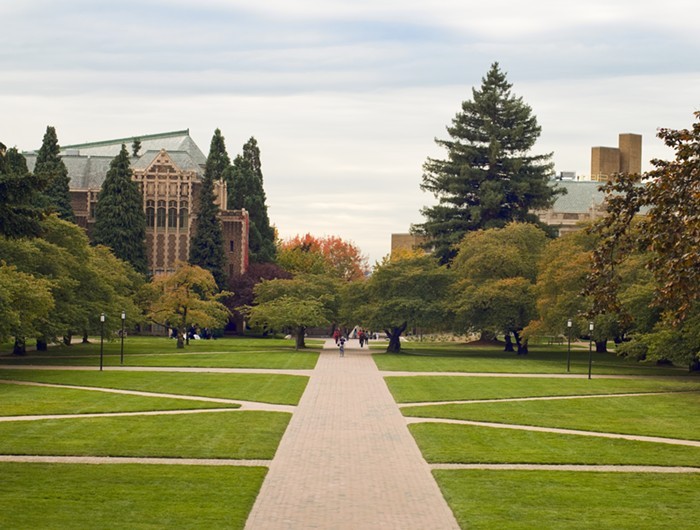On May 21, just over two months after the death of the Seattle Post-Intelligencer, a party was held in the lobby of the Seattle Art Museum to toast the first two months of the paper's online-only reincarnation, SeattlePI.com.
Waiters offered trays of razor-clam fritters with aioli, Beecher's cheese melted on toasted baguette slices, and mini-burgers. Hearst Corporation executives milled about. And Michelle Nicolosi, the site's executive producer, made introductions while staffers made small talk with the invitees—people who the start-up hopes will become fans and business partners.
How does a two-month-old website that's part of the struggling journalism industry manage to pay for a swank venue, free wine, and fancy hors d'oeuvres? Someone on the SeattlePI.com's marketing staff whispered that a lot of it was offered in trade for advertising. Which works for a night, but hints at a bigger question that hovers over this and two other recently launched Seattle news sites in Seattle: Can they really make the online-only model work?
SeattlePI.com, which started life with a large base of people already used to visiting the site and with the deep pockets of Hearst behind it, seems to be in the best position. According to Nicolosi, it drew 4.3 million unique users—meaning 4.3 million individuals—in April, an increase of 1.6 percent over the previous April. "We're very psyched and feeling very strong about the start that we've had," Nicolosi said during a presentation for advertisers in the SAM auditorium.
As she gave this presentation, Nicolosi was standing beneath a large image of a cat projected on a screen to demonstrate how popular the site's MySeattlePets feature has become. Another major draw, according to Nicolosi: photo galleries of celebrities and fashion shows. Generally missing: slides and boasts about, say, in-depth investigative journalism.
"They're there for the news, of course," Nicolosi said of the site's readers. "But everybody likes a little time-waster in the afternoon, maybe around lunch... I know some people have commented, 'How can you have 100 photos of that fashion show?' Well, we tracked the usership in these galleries and found that most of the people who start on page 1 are still there on page 100. So why not?" Nicolosi didn't say exactly how many people—or unique users—are clicking through those galleries, and it's worth noting that celebrity photos and pet pictures are not exactly a unique offering on the internet.
Pulitzer Prize–winning cartoonist David Horsey later explained in a comment on Slog, The Stranger's blog, that he saw no problem with this new fashion-and-pet-photo-based model of online journalism. "Most of my P-I friends and colleagues are now unemployed, and the newspaper to which I devoted my career is gone," he wrote. "If all those people looking at pictures from beauty pageants motivate businesses to buy the ads that pay for our journalism, that's fine with me."
Less flush, but no less interesting, is PubliCola, the no-frills political news and gossip site launched in January by former Stranger staffers Josh Feit and Sandeep Kaushik. Unlike the generalist SeattlePI.com, PubliCola has focused on state and local politics, along with weekly posts on food, books, and music. "Things have been going very well considering how new this whole endeavor is," Kaushik said. "On the financial side, we've reached a point where Josh is not at imminent risk of starvation—which is a modest achievement, but an achievement nonetheless." PubliCola earned early notice by breaking the news of Ron Sims's departure to take a post in President Obama's Department of Housing and Urban Development, and it now draws around 1,500 unique visitors every weekday. "It's not a huge audience, but certainly an influential one," Kaushik said.
There's also a breaking down of traditional barriers at PubliCola. While Kaushik blogs about politics and media for the site, he makes his money as a political consultant, with clients including Mayor Greg Nickels and King County executive candidate Dow Constantine. "It's an unusual arrangement, but not all that complicated," he said. "I don't write about anything that I'm involved with." They've landed some regular advertisers, are pursuing potential investors, and generally are riding their (admittedly small) success. "It is an immense amount of work," Kaushik said. "But as long as it keeps going up at this pace, I'm thrilled."
Less thrilled, and seemingly least likely to succeed, is the man behind the Seattle PostGlobe, which offers a newsy take on the city similar to what a number of other sites, including SeattlePI.com, are already offering.
Former P-I reporter Kery Murakami launched the site a month ago, relying on office space donated by KCTS 9 and a core of about seven unpaid former P-I employees. "It's been hard," Murakami said. "We're kind of making some improvements and kind of feeling a little hopeful that things are going to turn around. But it's going to have to happen pretty fast, because folks are going to have to get paying jobs at some point."
Murakami couldn't say how much traffic his site was getting, and when asked about the quality of his staff's work replied: "It hasn't been very good, frankly." But he has raised $9,500 in donations, hopes to start paying a few reporters soon, is excited about a new redesign, and still believes the site can add some depth to the local news conversation.
"Hopefully in the next month we'll start to establish ourselves." ![]()




















